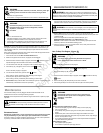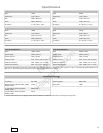
8
BRIGGSandSTRATTON.COM
Maintenance Chart
First 5 Hours
Change oil
Every8HoursorDaily
Check engine oil level
Every 50 Hours or Annually
Change engine oil
Check muffler and muffler guard
Annually
Replace spark plug
Check valve clearance *
* Not required unless engine performance problems are noted.
Carburetor Adjustment
Never make adjustments to the carburetor. The carburetor was set at the factory to
operate efficiently under most conditions. However, if adjustments are required, see any
Briggs & Stratton Authorized Dealer for service.
NOTICE: The manufacturer of the equipment on which this engine is installed specifies
the top speed at which the engine will be operated. Do not exceed this speed.
How To Replace The Spark Plug - Figure
7
Check the gap (A, Figure 7) with a wire gauge (B). If necessary, reset the gap. Install
and tightenthe sparkplug totherecommended torque.For gap settingor torque,see the
Specifications section.
Note: In some areas, local law requires using a resistor spark plug to suppress ignition
signals. If this engine was originally equipped with a resistor spark plug, use the same
type for replacement.
How To Access The Spark Plug - Figure
8 9
To access the spark plug, the snow hood must be removed as follows:
1. Remove the key (A, B Figure 8). Keep the key out of reach of children.
2. Grasp the choke control knob (J) and pull up to remove.
3. Remove the mounting screws (C).
4. Carefully remove the top part of the snow hood (D, Figure 9). Do not disconnect the
primer hose (E), if equipped, or the key switch wire (F).
5. The spark plug (G) can now be accessed.
6. Before installation of the snow hood, make sure that the primer hose, if equipped,
and the key switch wire are connected.
7. Mount the top part of the snow hood to the snow hood base(H). Make sure the top
interlocks with the base. Secure with the mounting screws.
8. Align the slots in the choke control knob with thetabs on the choke shaft (I) and then
push down to install. If the knob is not installed correctly, the choke will not operate.
9. Do not install the key until you are ready to start the engine.
Inspect Muffler And Spark Arrester - Figure
10
Running engines produce heat. Engine parts, especially muffler,
become extremely hot.
Severe thermal burns can occur on contact.
Combustible debris, such as leaves, grass, brush, etc. can catch fire.
WARNING
Allow muffler, engine cylinder and fins to cool before touching.
Remove accumulated debris from muffler area and cylinder area.
It is a violation of California Public Resource Code, Section 4442, to useor
operate the engineon anyforest-covered,brush-covered,or grass-covered land
unless the exhaust system is equipped with a spark arrester, as defined in
Section 4442, maintained in effective working order. Other states or federal
jurisdictions may have similar laws. Contact the original equipment
manufacturer, retailer, or dealer to obtain a spark arrester designed for the
exhaust system installed on this engine.
Remove accumulated debris from muffler area and cylinder area. Inspect the muffler (A,
Figure 10) for cracks, corrosion, or other damage. Remove the spark arrester (B), if
equipped, and inspect for damage or carbon blockage. If damage is found, install
replacement parts before operating.
WARNING: Replacement parts must be of the same design and installed
in the same position as the original parts. Other parts may not performas well, may
damage the unit, and may result in injury.
Air Filter
This engine is not equipped with an air filter. DO NOT use this engine for anything
other than snow removal.
How To Change The Oil - Figure
2 11
Used oil is a hazardous waste product and must be disposed of properly. Do not discard
with householdwaste. Check with yourlocal authorities,service center, or dealerfor safe
disposal/ recycling facilities.
Remove Oil
1. With engine off but still warm, disconnect the spark plug wire (A) and keep it away
from the spark plug (Figure 11).
Note: To access the spark plug wire, you must first remove the snow hood from the
engine. See How To Access The Spark Plug.
2. Remove the oil drain cap (E, Figure 2). Drain the oil into an approved receptacle.
3. After the oil has drained, install and tighten the oil drain cap.
Add oil
Place engine level.
Clean the oil fill area of any debris.
See the Specifications section for oil capacity.
1. Remove the dipstick (C, Figure 2) and wipe with a clean cloth.
2. Pour the oil slowly into the engine oil fill (B). Do not overfill. After adding oil, wait
one minute and then recheck the oil level.
3. Install and tighten the dipstick.
4. Remove thedipstick andcheck the oillevel. Itshouldbe at the topof the fullindicator
(D) on the dipstick.
5. Install and tighten the dipstick.
Storage
WARNING
Fuel and its vapors are extremely flammable and explosive.
Fire or explosion can cause severe burns or death.
When Storing Fuel Or Equipment With Fuel In Tank
Store away from furnaces, stoves, water heaters or other appliances that have
pilot lights or other ignition sources because they can ignite fuel vapors.
Fuel System
Fuel can become stale when stored over 30 days. Stale fuel causes acid and gum
deposits to form in the fuel system or onessential carburetor parts. To keep fuel fresh,
use Briggs & Stratton Advanced Formula Fuel Treatment & Stabilizer, available
wherever Briggs & Stratton genuine service parts are sold.
For engines equipped with a FRESH START
®
fuel cap, use Briggs & Stratton FRESH
START
®
available in a drip concentrate cartridge.
There is no need to drain gasoline from the engine if a fuel stabilizer is added according
to instructions.Run the enginefor 2 minutesto circulate thestabilizer throughout the fuel
system before storage.
If gasolinein the enginehas not beentreated witha fuel stabilizer, itmust be drained into
an approved container. Run the engine until it stops from lack of fuel. The use of a fuel
stabilizer in the storage container is recommended to maintain freshness.
Engine Oil
While the engine is still warm, change the engine oil.
Troubleshooting
Need Assistance? Go to BRIGGSandSTRATTON.COM or call 1-800-233-3723.
Not for
Reproduction


















